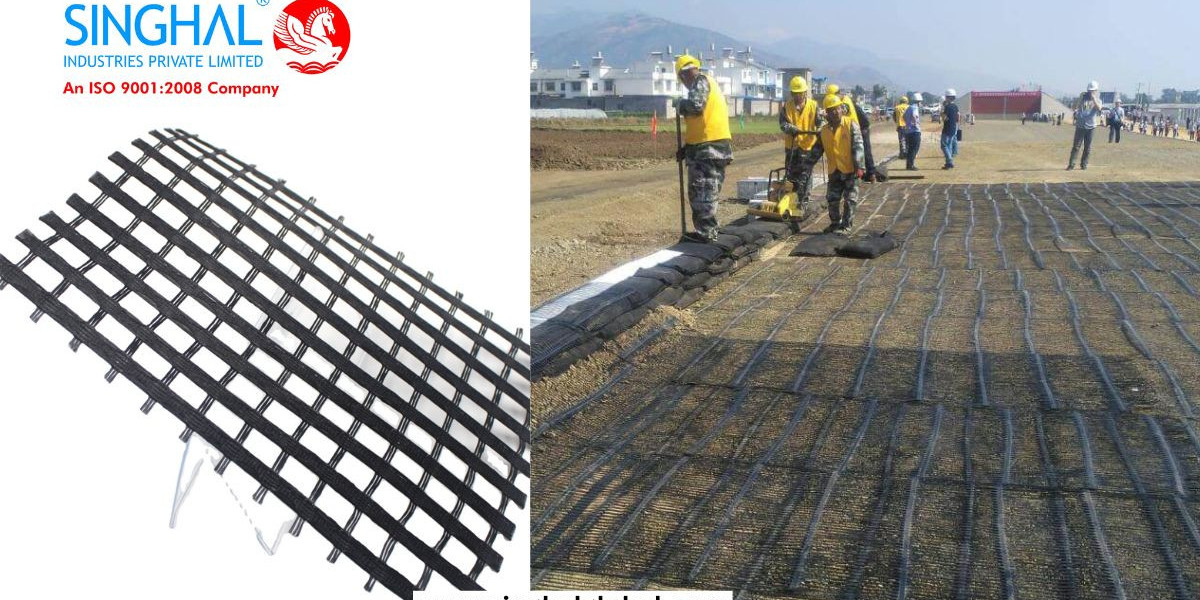In the age of rapid infrastructure development, ensuring stability, longevity, and sustainability in construction is more critical than ever. One product that has transformed geotechnical engineering and civil construction practices is the polyester geogrid. These high-performance synthetic grids are engineered to reinforce soil, improve load distribution, and reduce structural failure risks.
What is a Polyester Geogrid?
A polyester geogrid is a geosynthetic material made from high-tenacity polyester (PET) yarns, which are knitted or woven in a grid-like pattern and then coated with polymer resins such as PVC. This design provides strength in one or both directions, depending on whether the geogrid is uniaxial or biaxial.
Polyester geogrids are widely used in civil engineering applications, particularly in reinforcing soft soils, improving load-bearing capacity, and enhancing the structural integrity of roads, railways, embankments, and retaining walls.
Key Advantages of Polyester Geogrids
High Tensile Strength at Low Strain
Polyester geogrids provide excellent tensile strength and durability, even under constant stress. Their performance in both dry and wet conditions makes them ideal for long-term applications.Creep Resistance
Creep, or the slow deformation of materials under stress, is minimal in polyester geogrids, ensuring longevity in demanding load-bearing applications.Chemical and Biological Resistance
These geogrids resist degradation from soil acids, alkalis, and microorganisms, making them perfect for challenging environments.Cost Efficiency
By enhancing the stability of the soil and reducing the need for thick base layers, polyester geogrids help reduce material and labor costs.
Where Are Polyester Geogrids Used?
Polyester geogrids are indispensable in various infrastructure and geotechnical projects, including:
Road and Railway Reinforcement: Strengthening weak subgrades, reducing rutting and cracking.
Retaining Walls and Slopes: Providing lateral reinforcement for earth retention systems.
Landfills and Embankments: Preventing settlement and failure in high-fill structures.
Mining and Industrial Pads: Enhancing load support for heavy equipment and materials.
With construction booming worldwide, especially in emerging markets, the role of Geogrid manufacturers in India has become increasingly vital. Their ability to provide high-quality, cost-effective products tailored to local and international standards makes them essential players in the global supply chain.
India’s Competitive Edge in the Geogrid Market
India is rapidly gaining recognition in the global geosynthetics industry, with a growing number of PET geogrid exporters in India meeting international quality benchmarks. The country’s manufacturing ecosystem, supported by technological advancements and cost-effective production capabilities, allows Indian suppliers to offer exceptional value.
Many Polyester geogrid exporters in India work closely with civil engineers, infrastructure consultants, and construction companies to deliver project-specific solutions that meet or exceed global standards like ISO, ASTM, and CE.
In addition to exports, the domestic infrastructure sector benefits greatly from locally produced geogrids, which are now integral to major national projects involving highways, smart cities, and renewable energy installations.
Factors to Consider When Choosing a Polyester Geogrid
Tensile Strength Requirements
Depending on your project, you may need uniaxial or biaxial geogrids with specific strength ratings.Environmental Compatibility
Choose a geogrid with appropriate coatings to withstand UV exposure, chemicals, and moisture.Certifications and Standards
Reputable geogrid manufacturers in India ensure their products comply with relevant international testing standards.Logistics and Support
Trusted PET geogrid exporters in India offer end-to-end support, from product selection and testing to delivery and installation guidance.
Summary
Polyester geogrids are critical in modern infrastructure development, offering unmatched reinforcement, durability, and cost-efficiency. Whether it's stabilizing highways, strengthening railways, or supporting retaining structures, polyester geogrids provide a reliable, long-term solution.
India, with its growing capabilities and global reach, has emerged as a trusted source for geosynthetic products. With a network of innovative geogrid manufacturers in India, the country is well-equipped to meet the evolving demands of construction and geotechnical engineering.
Moreover, PET geogrid exporters in India and polyester geogrid exporters in India are expanding their footprint globally, ensuring that quality Indian engineering is helping build stronger, safer, and more sustainable infrastructure around the world.
FAQs
1. What is the difference between polyester and polypropylene geogrids?
Polyester geogrids offer superior creep resistance and tensile strength, especially at elevated temperatures, making them ideal for long-term load-bearing applications. Polypropylene geogrids are more chemically inert but are typically used in less demanding environments.
2. Are Indian polyester geogrids reliable for international use?
Yes. Many polyester geogrid exporters in India are ISO-certified and produce geogrids that meet ASTM, EN, and other international quality standards. Their products are already in use in Europe, the Middle East, and Southeast Asia.
3. Can geogrids reduce road maintenance costs?
Absolutely. Geogrids enhance pavement performance by minimizing base layer thickness, reducing settlement, and preventing cracks—leading to lower maintenance needs and longer-lasting roads.








